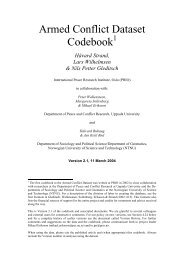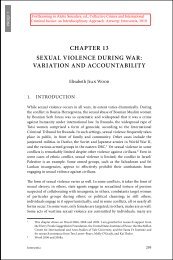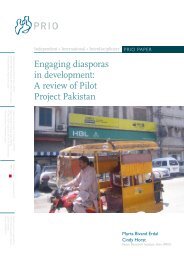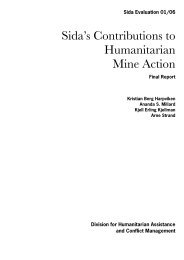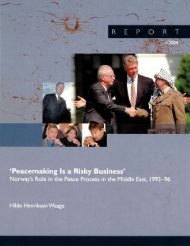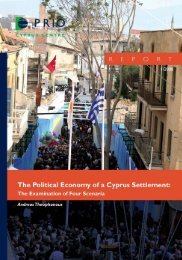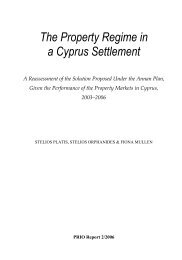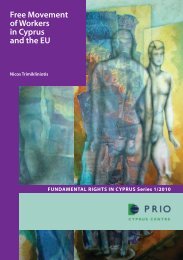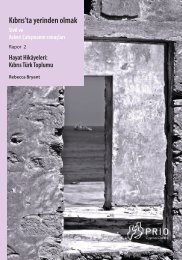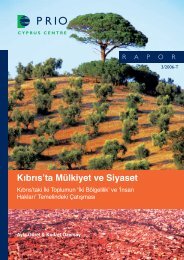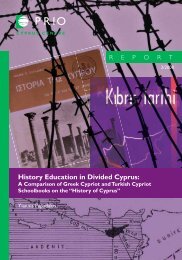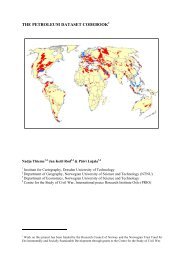Working Paper no. 5 - PRIO
Working Paper no. 5 - PRIO
Working Paper no. 5 - PRIO
You also want an ePaper? Increase the reach of your titles
YUMPU automatically turns print PDFs into web optimized ePapers that Google loves.
CENTER FOR<br />
Global Studies<br />
Project on Global Migration and Transnational Politics<br />
ISSN 1941-7594<br />
From “Refugee Warriors” to “Returnee Warriors”<br />
Militant Homecoming in Afghanistan and Beyond<br />
Kristian Berg Harpviken<br />
Centre for the Study of Civil War (CSCW)<br />
International Peace Research Institute, Oslo (<strong>PRIO</strong>)<br />
Global Migration and Transnational Politics<br />
<strong>Working</strong> <strong>Paper</strong> <strong>no</strong>. 5<br />
March 2008
This paper relates to the larger project ‘Going Home to Fight? Explaining Refugee<br />
Return and Violence’ (2008-2011) which is funded by the Research Council of Norway’s<br />
program on Poverty and Peace (POVPEACE).<br />
The Center for Global Studies at George Mason University was founded to promote<br />
multidisciplinary research on globalization. The Center comprises more than 100<br />
associated faculty members whose collective expertise spans the full range of disciplines.<br />
The Center sponsors CGS <strong>Working</strong> Groups, publishes the Global Studies Review, and<br />
conducts research on a broad range of themes.<br />
The Project on Global Migration and Transnational Politics, a partnership between CGS<br />
and the John D. and Catherine T. MacArthur Foundation, investigates how political<br />
dynamics around the globe have been transformed by new patterns of human mobility<br />
and the development of in<strong>no</strong>vative transnational social networks. The project sponsors<br />
research workshops, working papers, and conferences that all focus on developing a new<br />
research agenda for understanding how global migration has transformed politics.<br />
WEB: cgs.gmu.edu<br />
ISSN 1941-7594
Kristian Berg Harpviken<br />
From ‘Refugee Warriors’ to ‘Returnee Warriors’: Militant<br />
Homecoming in Afghanistan and Beyond<br />
By Kristian Berg Harpviken<br />
Why do some refugees, upon return to their countries of origin, engage in violent action?<br />
This paper takes as its point of departure that in some refugee situations all those who<br />
return do <strong>no</strong>t necessarily reintegrate peacefully; rather, a significant share engage in<br />
militant action. Amongst all refugee situations in the world, it is estimated that<br />
militarization is significant in some 15-20% of them, and post-return violent action seems<br />
particularly likely amongst those who were already mobilized while in exile. I will use<br />
literature on refugee warriors as my point of departure, and examine the relevance of the<br />
main factors emphasized in this literature to facilitate the understanding of what we may<br />
name returnee warriors. After a brief examination of the main contributions on refugee<br />
warriors, I will move on to look at three sets of explanatory factors: enabling<br />
environment, ideology, and organization. The paper draws primarily on insights from the<br />
three past decades of armed conflict in Afghanistan (see also: Harpviken, forthcoming).<br />
The main ambitions for the paper are to contribute to an expanding analytical framework<br />
for refugee warrior phe<strong>no</strong>mena, and move towards an agenda for future research.<br />
There are strong linkages between the reintegration of returnees, on the one hand,<br />
and the demobilization and reintegration of fighters on the other. As most observers point<br />
out, the successful reintegration of fighters is a precondition for fostering the security<br />
needed for the successful reintegration of returnees (see, for example, Faubert et al. 2005:<br />
27). Thus, there is a strong need to invest heavily in Disarmament, Demobilization and<br />
Reintegration (DDR) programs, although this poses serious moral dilemmas:<br />
DDR programs in post-war societies often arouse debate over whether combatants ...<br />
should be accorded special treatment over groups such as refugees and internally<br />
displaced people. (Sedra 2003: 16)<br />
A portion of the returnees are (current or former) fighters; and, vice versa, a portion of<br />
the fighters are found among the refugees. Nonetheless, it is common to distinguish<br />
sharply between fighters and returning refugees. The two are seen as distinct rather than<br />
overlapping groups, and the return of refugees, all of whom are assumed to be ‘civilians,’<br />
is seen to signify a successful peace process. Howard Adelman has examined the<br />
assumption that refugee return is a condition for—or at least a significant indicator of—a<br />
viable peace process, and he finds that that there is <strong>no</strong> relationship (Adelman 2002; see<br />
also Bhatia 2003; Chimni 2003; Eastmond & Öjendal 1999). More dramatically,<br />
however, is that the rapid return of refugees may threaten the viability of peace if they are<br />
actually fighters or are mobilized as fighters. In that case, the returnees themselves may<br />
represent a security threat, and hence undermine a peace process. 1 There is an<br />
1 This goes beyond the question of ‘absorptive capacity’, raised above, which focuses on the capacity of the<br />
community to assist and accommodate returnees, first and foremost in the eco<strong>no</strong>mic domain.<br />
1
From !Refugee Warriors" to !Returnee Warriors"<br />
understandable reluctance to realize that the same person may be a returning refugee and<br />
fighter—both victim and perpetrator. The ‘refugee warrior’ debate has yet to inform the<br />
analysis of return and reintegration.<br />
‘REFUGEE WARRIORS’<br />
Forced migration contexts are fertile grounds for violent collective action. This may seem<br />
obvious from today’s perspective, but when the term ‘refugee warriors’ was launched in<br />
the late 1980s, it was highly controversial. The term was coined by Astri Suhrke, and<br />
introduced through the collaborative work of Aristide Zolberg, Astri Suhrke and Sergio<br />
Aguayo (1986; 1989), particularly in the book Escape from Violence: Conflict and the<br />
Refugee Crisis in the Developing World. The term brought attention to an important, yet<br />
so far neglected, aspect of displacement. Zolberg, Suhrke and Aguayo define refugee<br />
warrior communities as:<br />
highly conscious refugee communities with a political leadership structure and<br />
armed sections engaged in warfare for a political objective, be it to recapture the<br />
homeland, change the regime, or secure a separate state (1989: 275)<br />
The refugee warrior concept challenges conventional images of refugees as victims,<br />
emphasizing their potential to be conscious subjects, even with a capacity for violent<br />
action. As such, the concept is also a challenge to international law, which is premised on<br />
the demarcation between refugees and activists. Despite a radical insistence on agency,<br />
however, the emphasis is on the root causes of conflict rather than on the mechanisms by<br />
which conflict leads to displacement—or to political mobilization amongst the displaced.<br />
Believing that refugee warriorism is on the rise, Zolberg, Suhrke and Aguayo find the<br />
root cause of the phe<strong>no</strong>me<strong>no</strong>n in a process of globalization where political and eco<strong>no</strong>mic<br />
inequality becomes increasingly evident. Driven from their home by repressive political<br />
regimes, radical groups launch armed struggles to gain political power in their state of<br />
origin. In doing this, the support of other states—host countries and great powers—plays<br />
a crucial role. While such alliances between states and opposition groups based in exile<br />
are <strong>no</strong>t new, they have grown more important in the post-World War II era for two<br />
reasons. First, there is the evolution of an ‘international refugee regime that can sustain<br />
large-scale civilian populations in exile for years’. Second, what the authors refer to as<br />
the ‘dominant ideology of democratic nationalism’ implies that exile-based opposition<br />
groups depend on a civilian population for legitimacy (1989: 277).<br />
Following the introduction of the term, there was virtually <strong>no</strong> work on refugee<br />
warriors for more than a decade. 2 From 2002 onwards, however, there have been three<br />
main contributions on the refugee warrior phe<strong>no</strong>mena by Fiona Terry (2002), Sarah<br />
Kenyon Lischer (2002, 2004), and Stephen John Stedman & Fred Tanner (2003). All of<br />
these are framed within a larger debate on humanitarianism, in large part inspired by the<br />
2 The only exceptions k<strong>no</strong>wn to this author are: Adelman 1998; Goodson 1990.<br />
2
Kristian Berg Harpviken<br />
realization that the refugee regime sustained Rwanda’s war perpetrators in the mid-1990s.<br />
A main concern is how humanitarian actors are to respond to the militarization of<br />
refugees. Analytically, however, there are significant differences between the three<br />
contributions:<br />
• Fiona Terry, in 2002, published Condemned to Repeat: The Paradox of<br />
Humanitarian Action. Her analytical focus is on the refugee regime. Militarized<br />
groups are assisted in misusing ‘humanitarian sanctuaries,’ which allow militants<br />
to hide and gives them independence based on humanitarian assistance. Finally,<br />
refugee camps facilitate control by militants who, in turn, gain legitimacy from<br />
their roles in camp management. For Terry, the humanitarian regime is both a<br />
necessary and sufficient factor in explaining refugee mobilization.<br />
• Sarah Kenyon Lischer published the book Dangerous Sanctuaries: Refugee<br />
Camps, Civil Wars and the Dilemmas of Humanitarian Aid, which came out in<br />
2005. Lischer is also preoccupied with the humanitarian dilemma, but she takes a<br />
broader analytical perspective by comparing the contribution of refugee relief<br />
with other factors, including the supportive role of the host state and that of other<br />
states. While the refugee regime plays a central role in Lischer’s account, the<br />
main factor that distinguishes refugee populations producing violence from those<br />
that don’t is the supportive role of states.<br />
• Stephen John Stedman and Fred Tanner have edited the volume Refugee<br />
Manipulation: War, Politics and the Abuse of Human Suffering, published in<br />
2003. They <strong>no</strong>te that militarization appears in some, but <strong>no</strong>t all, refugee crises,<br />
and are skeptical of a root cause orientation. In the volume’s conclusion, Stedman<br />
<strong>no</strong>tes two pathways to refugee mobilization. In some cases, such as Afghanistan<br />
during the Cold War, state support would breed mobilization regardless of the<br />
refugee regime. In other cases, such as Rwanda in the mid-90s, humanitarian<br />
naivety was a sufficient factor for militants to mobilize successfully.<br />
All of these authors privilege certain types of explanations: Zolberg, Suhrke and Aguayo<br />
the contradictory forces of globalization; Terry, Lischer, and Stedman & Tanner<br />
emphasize the role of humanitarian relief; and all the authors, with the exception of<br />
Terry, highlight the role of the host state as well as other states. In all these authorships,<br />
there is only scant attention to the internal dynamics of refugee mobilization. The main<br />
analytical focus is on the factors that allow or stimulate it. In the following, I will first<br />
look at factors that are part of the enabling environment for refugee mobilization,<br />
including the refugee regime and the role of state support, which figure so prominently in<br />
the existing literature. I will then move on to look at the role of ideology. Finally, I will<br />
examine organizational issues, and, on the whole, reflect on the relevance for our<br />
understanding of the return and reintegration of refugee warriors.<br />
3
From !Refugee Warriors" to !Returnee Warriors"<br />
THE ENABLING ENVIRONMENT<br />
With Charles Tilly’s From Mobilization to Revolution (1978), the debate on political<br />
mobilization turned much of its attention to the role of structures external to the group in<br />
enabling or preventing mobilization. Formulated in rational choice terms, the question is<br />
how the movement is going to be able to raise the resources necessary for rewarding or<br />
threatening members to come aboard, what Mancur Olson had earlier described as the<br />
problem of producing selective incentives (Olson 1965). The focus on opportunities and<br />
constraints goes a long way in explaining how resource-poor populations may be able to<br />
foster powerful political movements. This is a main element in all the works quoted on<br />
refugee warriorism, the international state system and the refugee regime being the two<br />
main elements, while attitudes of host populations and geographical features play a more<br />
marginal role as explanatory factors.<br />
The state figures prominently in most work on political mobilization, with a role<br />
<strong>no</strong>t only as the main threat and adversary, but also as a structure that may be influenced<br />
constructively by various means from lobbying to unrest and violence. The refugees and<br />
many IDPs have moved to a territory which is <strong>no</strong>t under the control of the state they<br />
oppose. This limits the state’s ability to threaten contenders. It also narrows down the<br />
ways in which contenders may influence the state, with violent action becoming a<br />
primary option. The host state is key for the freedom to maneuver. Lischer (2005: 30-33)<br />
suggests that two factors are key for host state response: capability and willingness. The<br />
host state’s relationship to the state of origin is essential, as is the extent to which the<br />
latter is in a position to threaten the former. Distant states, and great powers in particular,<br />
are also important factors (Zolberg, Suhrke & Aguayo 1986: 165), but their relative<br />
importance may have diminished with the end of the Cold War (Lischer 2000) as also<br />
indicated by the contrast between the massive refugee support to Afghans during the<br />
1980s versus the dwindling support of the 1990s. Moreover, there is a fundamental<br />
difference between host states (and other neighboring states) in that they are tied to the<br />
fate of the conflict-ridden country by virtue of their geographic location, whereas distant<br />
powers may choose whether or <strong>no</strong>t to engage. The role of the US in Afghanistan over the<br />
past 25 years, for example, has varied between virtually zero interest to being the major<br />
foreign power in the country.<br />
After refugees have gone home, the former host state, or certain actors within the<br />
host state, may find it in its interest to maintain the relationships that were built while the<br />
refugees were in exile. In this, former host states may even find it useful to follow the<br />
refugees home and establish their own presence in the country of origin in the form of<br />
diplomatic missions, educational institutions or other assistance programs. For example,<br />
soon after the Afghan regime change in 1992, key actors in Pakistan’s mujahedinsupporting<br />
apparatus popped up as active players on the Kabul scene. Such a presence<br />
may have multiple purposes: to provide political and military advice, to broker various<br />
kinds of material support, and to gather information on behalf of their own institutions.<br />
Ultimately, the purpose is to promote the installation of a ‘friendly government,’ and to<br />
prevent the coming to power of an unfriendly one. In protracted conflicts where armed<br />
interference through support to refugees has long been considered a legitimate tool, it is<br />
4
Kristian Berg Harpviken<br />
dangerously easy to continue a similar policy in the post-return phase. It is easy to<br />
harmonize the interest of host states in securing as immediate a return as possible and in<br />
continuing political collaboration upon return.<br />
A second dimension of the enabling structure, which offers both protection and<br />
humanitarian support, is the refugee regime. Zolberg and associates point out that once<br />
established, refugee warrior communities “tend to grow because they provide<br />
opportunities and even incentives for others to become politically active” (1986: 166).<br />
The ability of humanitarians to operate, of course, depends on the goodwill of host states.<br />
The willingness of the United Nations High Commissioner for Refugees (UNHCR) to<br />
compromise in the case of Afghans in Pakistan in the 1980s was, in part, related to the<br />
ideological climate of the Cold War, but also reflected that the agency had little leverage<br />
since the host country was <strong>no</strong>t a signatory to the Refugee Convention (Lischer 2004: 60).<br />
In practice, humanitarian assistance was an integral part of support to the Afghan<br />
resistance since refugee documents were only obtained upon having joined one of the<br />
political parties recognized by the Pakistani government (Amstutz, 1986: 229). The<br />
distinction between refugees and fighters, so fundamental in refugee law, is far removed<br />
from such grim realities.<br />
In relation to return, the most direct link is that a changing refugee regime<br />
prioritizes and encourages repatriation—in contrast to other solutions. In her case study<br />
from Bosnia-Herzegovinia, Sarah Lischer suggests that third country resettlement and<br />
local integration are potentially effective responses to refugee mobilization (2005: 145).<br />
Similarly, both options, third country resettlement and local reintegration, would preempt<br />
the potential for returnee warriorism. The problem, however, is that these options seem<br />
increasingly out of reach (Chimni 2005). Upon return, the refugee regime, and the<br />
humanitarian regime more generally, does <strong>no</strong>t play as prominent a role as during exile.<br />
Nonetheless, as long as humanitarian actors remain ig<strong>no</strong>rant about the possibility that<br />
returnees may be or may become warriors, there is a risk that they will support the<br />
production of violence. Some of the mechanisms may be similar to those in exile:<br />
protection (defining returnees as worthy of special treatment) and strengthening leaders<br />
(serving as intermediaries for material support to returnees). Returnees who have lived<br />
with refugee support in exile may have learnt the rules of the game, and seek to<br />
manipulate the humanitarian regime upon return. In 1997-98, for example, the Taliban<br />
cleverly got various humanitarian agencies to support Pashtun IDPs who had escaped<br />
from fighting in Badghis and Faryab, while simultaneously drawing fighters from these<br />
populations.<br />
In the refugee warrior literature, considerable weight is placed on geographical<br />
features. Closeness to a state border is considered important, <strong>no</strong>t only because it<br />
facilitates incursions into the country of origin, but also because to residents it serves as a<br />
constant reminder of war and the need for protection by militants (Zolberg, Suhrke,<br />
Aguayo 1989: 277). As important, however, is the reception by the population in areas of<br />
settlement. For the Afghan refugees in Pakistan, the Islamic obligation, rooted in the<br />
hijra, to assist co-believers was reinforced by joint Pashtun ethnicity and hospitality<br />
<strong>no</strong>rms, as well a history of frequent interaction across a porous border. In time, this gave<br />
5
From !Refugee Warriors" to !Returnee Warriors"<br />
way to an integration that was so close that the Taliban regime, which ruled most of<br />
Afghanistan in the latter half of the 1990s, can only meaningfully be described as a<br />
transnational Afghan-Pakistani phe<strong>no</strong>me<strong>no</strong>n, bred mainly in religious schools in<br />
Pakistan.<br />
Geographical proximity, a history of porous borders, and identity commonalities<br />
between hosts and (departing) refugees are all factors that may strengthen both the<br />
capability and willingness—to use Lischer’s terms—of former host states to engage.<br />
More generally, those are also factors, which give returnee warriors more room to<br />
maneuver. Returnees may settle in areas different from the ones they left, either because<br />
the political and eco<strong>no</strong>mic situation at their original home has changed dramatically, or—<br />
as is often the case following prolonged exile—their preferences have changed. The<br />
ramifications may be massive, particularly if political fault lines coincide with ethnic or<br />
religious distinctions.<br />
IDEOLOGY<br />
Ideology, states Sidney Tarrow (1998; 21), serves both to “justify, dignify and animate<br />
collective action.” Ideology reinforces identities, thereby helping individuals respond to<br />
the question of whose side they are on, and permitting diverse groups to focus on<br />
common aims. Importantly, neither identities <strong>no</strong>r ideologies are fixed. Rather, movement<br />
members engage actively in what David S<strong>no</strong>w and Robert Benford (1988) have referred<br />
to as ‘framing work,’ or continuously working on their ideological justification. This<br />
framing, however, does <strong>no</strong>t take place in a vacuum; states, the media and international<br />
organizations also contribute to framing, sometimes to the extent that movements’<br />
attempts at framing are rendered useless.<br />
Refugee warrior literature puts considerable emphasis on ideological frames. In<br />
the account of Zolberg, Suhrke and Aguayo, for example, refugeehood serves an essential<br />
function in legitimizing violent struggle, mediated both by the refugee regime and ideals<br />
of democratic nationalism (1989: 277). Also Lischer (2005: 8-9) and Terry (2002: 42-47)<br />
emphasize the legitimizing function of the refugee regime. The emphasis, however, is on<br />
justifying armed resistance to the larger world in order to underpin continued support,<br />
rather than on legitimizing a just cause internally, for movement members.<br />
After the withdrawal from Afghanistan in 1989, refugee warrior leaders made<br />
violent threats to discourage return (see, for example, Rizvi 1990). This underlines the<br />
key role that the refugee population has for legitimizing continued resistance from exile,<br />
and, vice versa, timing return so that this legitimization effect is saved for a new regime,<br />
rather than the importance of boosting the image of the one in power. The cognitive<br />
distinction between refugees and warriors rooted in the refugee regime makes it possible<br />
for a new regime to gain international legitimacy through a return movement that may, at<br />
the same time, be a necessary import of fighters. The principle of a ‘right to return’,<br />
equally fundamental within refugee law and even more so with the increasing pressure on<br />
host country integration and third country resettlement, also takes attention away from<br />
6
Kristian Berg Harpviken<br />
the potential that returning refugees may have a destabilizing effect and even contribute<br />
directly as active fighters.<br />
The image of displaced people as victims of circumstances beyond their control<br />
can also be useful for internal purposes, contributing to a sense of common purpose and a<br />
justified cause. With a focus on internal legitimization in the Afghan resistance, Shahrani<br />
(1995) has argued that religious institutions—jihad and hijra—have played a key role.<br />
Jihad refers to religious struggle with resistance as one avenue of action, whereas hijra<br />
refers to religiously motivated flight modeled on the narrative of Mohammad’s flight to<br />
Medina (see also Edwards 1986). In Shahrani’s account, the two are mutually<br />
reinforcing, providing a religious justification for a violent response to being driven out<br />
by infidels. The refugees from Mecca severed all ties with those who did <strong>no</strong>t join the<br />
flight, and established tight bonds with the host population and the emerging community<br />
that became the nucleus of the Ummah, the community of Muslims.<br />
Eight years after the original departure, Mecca fell to the community of ‘refugee<br />
warriors’ returning from Medina. Similar to the first Muslims, argues Shahrani, the<br />
Afghan refugees have proven reluctant to distinguish between the decision to flee and the<br />
obligation to resist oppression (1995: 200). Like in the original narrative, return is an<br />
integral part of the religious obligation. The prophet and his followers returned as<br />
warriors, overthrew the sitting regime and established a legitimate government. In<br />
Shahrani’s account, Muslim identity is linked to particular narratives, jihad and hijra, and<br />
together the two have a mobilizing effect. Both in the original narrative and in the<br />
Afghanistan of recent times, jihadic obligation is rooted in the maintenance, and even<br />
cultivation, of a collective during the time in exile. Ideologies, however, may be formed<br />
in settings that are fairly insulated from the situation in the state of origin, and may<br />
become particularly inflexible when <strong>no</strong>t being molded in the everyday interaction with<br />
political opponents. At the extreme, therefore, they may prevent reconciliation and<br />
promote further violent conflict. Such incompatibility of worldviews may be particularly<br />
strong in the aftermath of protracted (or multigenerational, as in the Palestinian case)<br />
exiles.<br />
Identity formation in exile is the main issue in Lisa Malkki’s celebrated Purity<br />
and Exile, based on fieldwork among Hutu refugees in Tanzania, where she compares<br />
refugees settled in camps with those living dispersed in towns. In Malkki’s account, focus<br />
is on the construction of national consciousness in exile. The camp refugees work to<br />
refine ethnic boundaries in a continuous process of constructing their history as a people<br />
unjustly exiled, which brings them to resist intermarriages or any form of local<br />
integration. The town refugees do their best to avoid classification, both as refugees and<br />
as Hutus, and they play on multiple identities in seeking local integration. For the camp<br />
refugees, the exile project is to become a nation, and international opinion is perceived as<br />
the ultimate arbitrator in the struggle for justice (1995: 251). This is reminiscent of the<br />
emphasis on the legitimizing function of democratic nationalism by Zolberg and<br />
associates.<br />
7
From !Refugee Warriors" to !Returnee Warriors"<br />
For the camp refugees, argues Malkki, exile is seen as a period of purification and<br />
political empowerment, as the centre of political change in the home country (1995: 230).<br />
Return is the unquestionable objective, and violence is the legitimate means to resurrect<br />
past injustice and gain power in the country of origin. In Malkki’s case, there are only<br />
two options. One is to refine ones identity in exile through cultivating difference from the<br />
host population in preparation for a politicized return. The second is to play down the<br />
differences from the host population in seeking enduring integration. There is, however, a<br />
third possible trajectory: refugees (or other migrants) may cultivate an identity — tribal,<br />
ethnic, religious or otherwise — which they share with all or parts of the host population.<br />
Over time, such an identity project may serve to reinforce existing, or even form new,<br />
types of transnational identities with political repercussions. The Taliban, originating<br />
mainly in the madrasas of Pakistan, became such a movement that was formed from an<br />
amalgamation of Deobandi-inspired Islamic ideology and Pashtun traditionalist values<br />
(increasingly also Al Qaeda militancy) that effectively spanned the boundary between<br />
Afghanistan and Pakistan. 3<br />
ORGANIZATION<br />
Social institutions—such as schools, religious congregation sites or community<br />
assemblies—can serve as platforms for political mobilization. In the study of refugee<br />
warriors, there is considerable agreement that camp-settled refugees, as opposed to selfsettled<br />
ones, are the ones that are likely to be politically mobilized. Lischer (2004: 145),<br />
for example, suggests that integration in the host country prevents military engagement.<br />
My own work on Afghan refugees in Iran, in contrast, suggests that a significant degree<br />
of military engagement, including host state support, is also possible amongst self-settled<br />
refugees (Harpviken 2006: 181-185; forthcoming). 4 The facilities for the displaced and<br />
for the military units are often separate, argues Zolberg, Suhrke and Aguayo (1989: 276).<br />
Sites for the military units, however, are even more important when the recruits are<br />
drawn from self-settled refugees. Furthermore, in the case of camp-settled refugees, the<br />
lines between the refugee camp and the military camp are blurred, and fighters are likely<br />
to circulate between the two. A second type of institution that proved particularly<br />
important in the Afghan case is the centre of Islamic training, the madrasa, already<br />
discussed above. A massive expansion of the madrasa system in Pakistan made it into<br />
primary centers for ideological training and for recruitment (Harpviken 1997). The<br />
madrasas were central recruitment grounds for the resistance parties in the 1980s, as they<br />
were for the Taliban in the 1990s.<br />
Refugee camps have little role to play upon return, but there are cases where<br />
refugee camps are sustained for years after repatriation starts and serve as an integral part<br />
3 A different example relates to those of Afghanistan’s shia population who became enrolled in shia<br />
religious training institutions in Iran. Many of those came to identify themselves with a Khomeini-style<br />
Islamism. Throughout the past two and a half decades of war, the tensions between such a Islamist project<br />
and a nationalist Hazara project have run high, inspiring considerable fighting (the Hazara constitute at<br />
least 90% of Afghanistan’s shia population, and vice versa) (Harpviken 1998).<br />
4 One main difference – born out by the comparison between Afghans in Iran vs. in Pakistan – is that in<br />
camp-settlements it is likely that there is a significant international presence and reporting. When selfsettlement<br />
is the main pattern, it is likely that such presence is either marginal or <strong>no</strong>n-existing.<br />
8
Kristian Berg Harpviken<br />
of transnational networks in which returnees are also a part. It may also be that returnees<br />
end up in camp-like settings (IDP camps included) upon return, where one can recognize<br />
some of the properties of the refugee camp. Other exile-based institutions may be brought<br />
back home as part of the return movement, such as schools, or they may remain an<br />
important point of reference in exile for those who have returned, perhaps even tied to a<br />
continued refugee administrative system existing in exile which continues to indirectly<br />
assist those who have returned.<br />
Collective action thinking in the 1980s increasingly came to appreciate the<br />
importance of social networks for activism (e.g. McAdam 1986). 5 Rather than<br />
individually held preferences guiding choices, people tend to act jointly with relevant<br />
others. Those who escape war often do so as part of larger collectives (Allen & Hiller<br />
1986; Harpviken 2006). In many instances, those who flee together also settle together in<br />
exile, and refugee camps are often composed of numerous tightly knit groups. Flight<br />
collectives may be based on groups that were already politically mobilized and became<br />
subject to government countermeasures, what Zolberg et al. (1989: 25) typologizes as the<br />
‘activist’ ideal type and Lischer (2004: 24-28) refers to as ‘state-in-exile refugees’. The<br />
sequence, however, may also be different, as when collectives sharing a political project<br />
escape prior to taking up arms, in the realization that opposition can only be launched<br />
from a safe distance. Within communities of the displaced, old and new ties serve a key<br />
function in new recruitments into violent resistance (Zolberg, Suhrke and Aguayo 1989:<br />
277). 6 Similarly, there may be different patterns of mobilization in the context of return.<br />
The genuine ‘returnee warrior’ is somebody who is part of a military entity whilst in<br />
exile, and who returns as part of this group. This implies both an obligation to contribute<br />
to the assertion of the group’s power and an expectation that the group will offer<br />
protection to the fighter and his dependents. Such groups, which may be rooted in<br />
commonality of origin and identity, tend to be quite robust. Peter Bearman, in a study of<br />
desertion during the American Civil War, has suggested that military units rooted in<br />
existing modes of solidarity were late, but that their members acted jointly once desertion<br />
was on the agenda. Entities based on individual recruitment started fragmenting earlier<br />
but took a much longer time to collapse (Bearman 1991). A second option is that refugees<br />
who are <strong>no</strong>t politically or militarily active in exile are recruited upon return. 7 This could<br />
be explained by socio-eco<strong>no</strong>mic factors, such as the lack of alternative employment, or it<br />
may be explained by the need to gain protection in a situation where the state is <strong>no</strong>t<br />
capable of doing so.<br />
5 See also Hardin 1995: chapter 2; Tarrow 1998: 22-23<br />
6 In relation to return of refugee warriors, Bearman’s suggestion, based on desertion patterns in the<br />
American Civil War, that fighting units built on solidary ties are slower to demobilize, but are likely to do<br />
so more effectively once they start, may be a source of inspiration. (Bearman 1991)<br />
7 One possibility may be that a small returning radicalized group sets itself up as the vanguard of a new<br />
opposition in the home country, recruiting primarily amongst people who have <strong>no</strong>t been exiled at all. This<br />
would be similar to a sequence which seems fairly common in refugee mobilization, where a radicalized<br />
group escape and recruit amongst other refugees who were <strong>no</strong>t necessarily politically active prior to flight.<br />
9
From !Refugee Warriors" to !Returnee Warriors"<br />
Leadership is a different aspect of organization. For example, Alain Guillo, Jean-Jose<br />
Puig and Olivier Roy—close observers of the Afghan exodus in the early 1980s—<br />
claimed:<br />
A hejrat protest exodus is always collective, organized and inspired by traditional<br />
<strong>no</strong>tables … it implies the movement of a structured group to a<strong>no</strong>ther country, usually<br />
Pakistan, where it retains its cohesion for a certain length of time (Guillo, Puig & Roy<br />
1983: 140). 8<br />
Once in exile, however, traditional leaders may find it difficult to retain their power. In<br />
camps, influence over aid distribution is key, and many observers found that in this<br />
environment, young, educated, English-speaking men fare much better than the<br />
traditional <strong>no</strong>tables (e.g. Ahmed 1980; Centlivres & Centlivres-Demont 1988). Links to<br />
the host state play as important a role: in the Pakistani case the main resistance leaders<br />
were recruited from a small group of Afghan Muslim Brotherhood associates who had<br />
left home in the first half of the 1970s to launch armed struggle against their own regime,<br />
having gained the tacit support of the host government. Ultimately, the mobilization of<br />
refugee warriors may entail a degree of force by leaders within the population, as<br />
Stedman and Tanner maintain in their insistence that the manipulators of refugees are the<br />
warrior leadership (2003: 3). 9 In the Afghan case, those who had left in the early 1970s<br />
became the vanguard of the resistance, appointed by Pakistan’s intelligence services, to<br />
whom they were already well k<strong>no</strong>wn. Unless there had been a Soviet invasion followed<br />
by a massive refugee flow, these pioneer activists would most likely have remained an<br />
irrelevant crowd of exile extremists.<br />
Refugee warrior leaders are likely to be amongst the first to return in the context<br />
of regime change, and they are likely to possess many of the resources needed to gain<br />
powerful positions. Their long-term fate, however, may be more uncertain. In the case of<br />
post-1992 Afghanistan, it seems there was a partial reinvigoration of traditional modes of<br />
leadership. As the enabling resource environment of humanitarian aid that empowered<br />
the new elites in exile is <strong>no</strong>t there anymore, old elites may be able to benefit from land<br />
and other resources at home and gradually rebuild their influence. This may imply that<br />
the ‘new leaders’ lose out in the longer term, in some cases to the extent that their status<br />
changes from well-respected resistance leaders to despised warlords, with the inherent<br />
risk that they become ‘spoilers’.<br />
8 Translation adapted from BIA (1985: 14). See also Centlivres & Centlivres-Demont (1988b), Edwards<br />
(1986).<br />
9 Lischer (2004: 154-156) also suggests that aid agencies may revert to influencing leadership amongst<br />
refugees in order to prevent or reduce mobilization pressure.<br />
10
Kristian Berg Harpviken<br />
CONCLUSIONS<br />
The reintegration of refugee warriors is a central challenge in many post-conflict<br />
transitions. Placing this central, but <strong>no</strong>t talked about, issue on the agenda is important in<br />
itself. As important, however, is that we <strong>no</strong>w have an embryonic term and fragments of a<br />
research agenda. To make progress, we need to formulate a consistent research agenda<br />
with a parallel focus on theoretical and methodological approaches, while maintaining an<br />
awareness of the possible policy impact.<br />
Theoretically, refugee warrior literature distinguishes between types of refugee<br />
populations, which are seen to have varying propensity for mobilization. Similarly, we<br />
may build a typology of returnees based on an understanding of the context for return. It<br />
may prove necessary to include the conditions at home, the conditions in exile, and the<br />
original causes for departure, which would lead to a number of trajectories that could—or<br />
could <strong>no</strong>t—lead to mobilization of refugees.<br />
To pursue such an agenda, the first step is an intensified engagement with the<br />
existing literature on refugee warriors, as well as literature on post-conflict transitions,<br />
particularly demobilizations. The next step is to identify a small number of cases with<br />
ample documentation of different distinct patterns of returnee engagement. In the final<br />
stage, a larger sample, including at least all conflict terminations in the post Cold War<br />
era, should be made subject to systematic comparative analysis.<br />
A debate on refugee warriors in the post-conflict phase challenges existing<br />
policies and practice. At the intersection between two issues, the return and reintegration<br />
of refugees on the one hand and the disarmament, demobilization and reintegration<br />
(DDR) of fighters on the other, research on returnee warriors has the potential to inform<br />
both.<br />
REFERENCES<br />
Adelman, Howard, 1998. ‘Why Refugee Warriors are Threats’, The Journal of Conflict Studies,<br />
18(1): 49-69.<br />
Adelman, Howard, 2002. ‘Refugee Repatriation’, in Stephen John Stedman, Donald Rotchild &<br />
Elizabeth M. Cousens, eds, Ending Civil Wars: The Implementation of Peace<br />
Agreements. Boulder, CO: Lynne Rienner (273-302).<br />
Ahmed, Akbar S. 1980. ‘Resettlement of Afghan Refugees and the Social Sciences’, Journal of<br />
South Asian and Middle Eastern Studies, 4(1): 77-89.<br />
Allen, Rebecca & Harry H. Hiller, 1985. ‘The Social Organization of Migration: An Analysis of<br />
the Uprooting and Flight of Vietnamese Refugees’, International Migration 23(4): 434–<br />
452.<br />
Amstutz, J. Bruce, 1986. Afghanistan: The First Five Years of Occupation, Washington DC:<br />
National Defense University Press.<br />
11
From !Refugee Warriors" to !Returnee Warriors"<br />
Bhatia, Michael, 2003. ‘Repatriation under a Peace Process: Mandated Return in the Western<br />
Sahara’, International Journal of Refugee Law 15(4): 786-822.<br />
Bearman, Peter, 1991. ‘Desertion as Localism: Army Unit Solidarity and Group Norms in the<br />
U.S. Civil War’, Social Forces, 70(2): 321-342.<br />
BIA, 1985. ‘Report on the Displaced Persons in Afghanistan: International Humanitarian Inquiry<br />
Commission’, Paris: Bureau International Afghanistan.<br />
Centlivres, Pierre & Micheline Centlivres-Demont, 1988b. ‘The Afghan Refugees in Pakistan: A<br />
Nation in Exile’, Current Sociology 36(2): 71–92.<br />
Chimni, B. S., 2003. ‘Post-conflict Peacebuilding and the Return of Refugees: Concepts,<br />
Practices and Institutions’, in Edward Newman & Joanne Van Selm, eds, Refugees and<br />
Forced Displacement. Tokyo: United Nations University Press (195-220).<br />
Edwards, David Busby, 1986. ‘Marginality and Migration: Cultural Dimensions of the Afghan<br />
Refugee Problem’, International Migration Review 20: 313–328.<br />
Faubert, Carrol; Abdullah Mojadeddi & Abdul Hai Sofizada, 2005.‘Repatriation and<br />
Reintegration: An Appraisal of Progress in Afghanistan’ Kabul: United Nations High<br />
Commissioner for Refugees.<br />
Eastmond, Marita & Joakim Öjendal, 1999. ‘Revisiting a 'Repatriation Success': The Case of<br />
Cambodia’, in Richard Black & Khalid Koser, eds, The End of the Refugee Cycle:<br />
Refugee Repatriation and Reconstruction. New York: Berghahn Books (38-55).<br />
Guillo, Alain; Jean-Jose Puig & Olivier Roy, 1983. ‘La guerre en Afghanistan: Modifications des<br />
deplacements traditionnels de populations et emergence de <strong>no</strong>uveaux types de<br />
circulations’, Eth<strong>no</strong>logica Helvetica 7: 139–153.<br />
Gurr, Ted Robert, 1971. Why Men Rebel, Princeton MA, Princeton University Press.<br />
Hardin, Russel, 1995. One for All: The Logic of Group Conflict, Princeton MA: Princeton<br />
University Press.<br />
Harpviken, Kristian Berg, 1997. ‘Transcending Traditionalism: The Emergence of Non-State<br />
Military Formations in Afghanistan’, Journal of Peace Research 34(3): 271–287.<br />
Harpviken, Kristian Berg, 1998. ‘The Hazara of Afghanistan: The Thorny Path Towards Political<br />
Unity: 1978-1992.’ in Post-Soviet Central Asia, edited by Touraj Atabaki and John<br />
O'Kane. London: Tauris.<br />
Harpviken, Kristian Berg, 2006. ‘Networks in Transition: Wartime Migration in Afghanistan’,<br />
Dr. polit. dissertation, Department of Sociology and Human Geography, University of<br />
Oslo.<br />
12
Kristian Berg Harpviken<br />
Harpviken, forthcoming. ‘The Return of the Refugee Warrior: Migration and Armed Resistance<br />
in Herat’, in Understanding Afghanistan, edited by Angela Schlenkhoff & Ceri Oeppen,<br />
London: Hurst & Co.<br />
Lischer, Sarah Kenyon, 2000. Refugee Involvement in Political Violence: Quantitative Evidence<br />
from 1987-1998’, New Issues in Refugee Research <strong>Working</strong> <strong>Paper</strong>, <strong>no</strong>. 26, Geneva:<br />
United Nations High Commissioner for Refugees.<br />
Lischer, Sarah Kenyon, 2003. ‘Collateral Damage: Humanitarian Assistance as a Cause of<br />
Conflict’, International Security, 28(1): 79-109.<br />
Lischer, Sarah Kenyon, 2005. Dangerous Sanctuaries: Refugee Camps, Civil Wars and the<br />
Dilemmas of Humanitarian Aid. Ithaca, NJ: Cornell University Press.<br />
Loescher, Gil, 1992. ‘Refugee Movements and International Security’, Adelphi <strong>Paper</strong>s 268.<br />
London: International Institute for Strategic Studies.<br />
Loescher, Gil, 2005. ‘Protracted Refugee Situations: Domestic and International Security<br />
Implications’, Adelphi <strong>Paper</strong>s 375. London: International Institute for Strategic Studies.<br />
Malkki, Lisa H., 1995. Purity and Exile: Violence, Memory and National Cosmology Among the<br />
Hutu Refugees in Tanzania. Chicago, IL: University of Chicago Press.<br />
McAdam, Doug, 1986. ‘Recruitment to High Risk Activism: The Case of Freedom Summer’,<br />
American Journal of Sociology, 92: 64-90.<br />
Melucci, Alberto, 1996. Challenging Codes: Collective Action in the Information Age,<br />
Cambridge: Cambridge University Press.<br />
Murshed, Mansoob, 2002. ‘Conflict, Civil War and Underdevelopment: An Introduction’,<br />
Journal of Peace Research, 39(4): 387-393.<br />
Oberschall, Anthony, 1973. Social Conflict and Social Movements, Englewood Cliffs NJ:<br />
Prentice-Hall.<br />
Olson, Mancur, 1965. The Logic of Collective Action. Cambridge, MA: Harvard University Press.<br />
Rizvi, Gowher. 1990. "The Afghan Refugees: Hostages in the Struggle for Power." Journal of<br />
Refugee Studies vol. 3:144-161.<br />
Salehyan, Idean & Kristian Skrede Gleditsch, forthcoming. ‘Refugees and the Spread of Civil<br />
War’, International Organization.<br />
Sedra, Mark, 2003. New Beginnings or Return to Arms? The Disarmament, Demobilization &<br />
Reintegration Process in Afghanistan. <strong>Paper</strong> presented at the conference ‘State<br />
Reconstruction and International Engagement in Afghanistan’, Bonn, 30 May-1 June.<br />
Shahrani, M. Nazif, 1995. ‘Afghanistan’s Muhajirin (Muslim “Refugee -Warriors”): Politics of<br />
Mistrust and Distrust of Politics’, in E. Valentine Daniel & John Chr. Knudsen, eds,<br />
Mistrusting Refugees. Berkeley, CA: University of California Press (13–35).<br />
13
From !Refugee Warriors" to !Returnee Warriors"<br />
Smelser, Neil, 1962. Theory of Collective Behaviour, London: Routledge and Kegan Paul.<br />
S<strong>no</strong>w, David E. and Robert Benford, 1988. ‘Ideology, Frame Resonance, and Participant<br />
Mobilization’, in Bert Klandermans, Hanspeter Kriesi and Sidney Tarrow, From<br />
Structure to Action: Comparing Social Movement Research Across Cultures,<br />
International Social Movement Research, vol. 1, Greenwich CO: JAO Press, pp. 197-217.<br />
Stedman, Stephen John & Fred Tanner, eds, 2003. Refugee Manipulation: War Politics and the<br />
Abuse of Human Suffering. Washington, DC: Brookings Institution Press.<br />
Suhrke, Astri, 1995a. ‘Analysing the Causes of Contemporary Refugee Flows’. Luxembourg:<br />
Office for Official Publications of the European Communities, (201–221).<br />
Suhrke, Astri, 1995b. ‘Refugees and Asylum in the Muslim World’, in Robin Cohen, ed., The<br />
Cambridge Survey of World Migration. Cambridge: Cambridge University Press (457–<br />
460).<br />
Tarrow, Sidney, 1998, Power in Movement: Social Movements and Contentious Politics (2nd ed),<br />
Cambridge: Cambridge University Press.<br />
Terry, Fiona, 2002. Condemned to Repeat: The Paradox of Humanitarian Action. Ithaca, NJ:<br />
Cornell University Press.<br />
Tilly, Charles, 1978. From Mobilization to Revolution. Reading, MA: Addison-Wesley<br />
Publishing Company.<br />
Zolberg, Aristide; Astri Suhrke & Sergio Aguayo, 1986. ‘International Factors in the Formation<br />
of Refugee Movements’, International Migration Review 20(2): 151–169.<br />
Zolberg A., Suhrke A., Aguayo S. 1989. Escape from Violence: Conflict and the Refugee Crisis<br />
in the Developing World. New York: Oxford University Press.<br />
14



